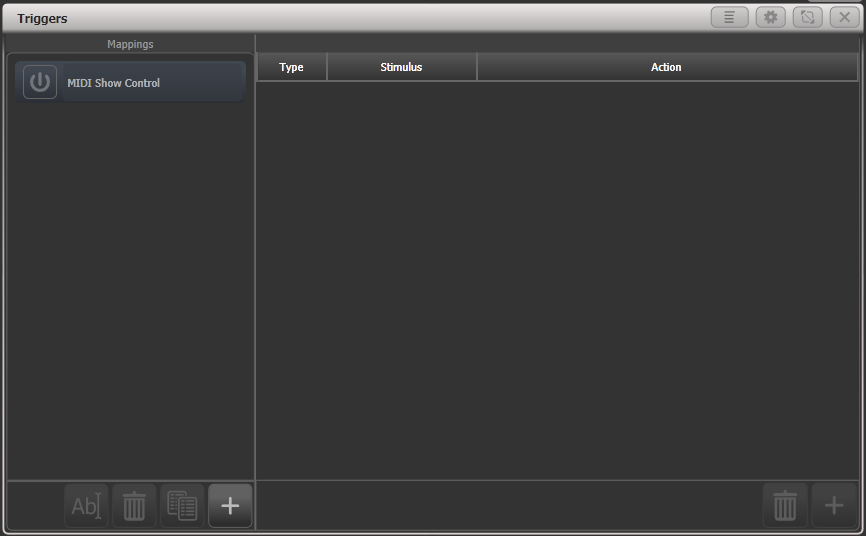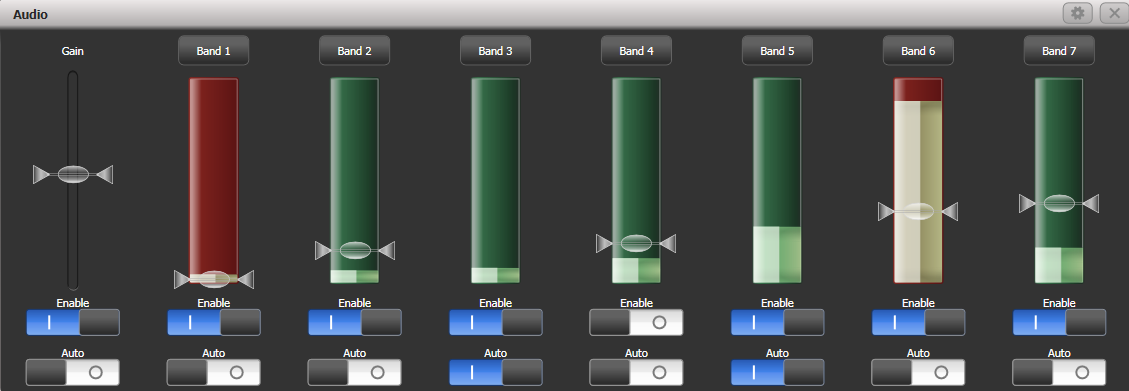MIDI, DMX or audio triggering
You can set up the console to allow most features to be triggered by external events. This is very useful in complex shows or when using in an automated setup.
Audio trigger (sound to light) requires special hardware which is currently only available on the Quartz and Arena consoles. The line in socket on other consoles cannot be used for audio trigger.
Connecting Remote Trigger Sources
To connect a MIDI source, connect it to the MIDI in connector on the console. USB-MIDI devices supporting the DirectX MIDI driver may also be used on all consoles except T1. For the T2 this would allow you to connect a MIDI fader controller to give you real playback faders.
DMX inputs are connected to one of the DMX output connectors using a DMX male to male gender changer cable. (This is a simple plug to plug cable with all pins wired straight through, i.e. 1-1, 2-2 and 3-3). Titan Mobile may require an update of the USB Expert software to enable this function, this can be downloaded from the Avolites website.
Audio input is connected to the dedicated audio in jack (not the line in jack on the motherboard) -- available on Quartz and Arena only.
The Arena console has a switch trigger input on a jack socket.
Setting up Remote Triggering
Enter System mode and select Triggers. The Triggers window will open.

The left hand side of the window has a list of trigger sets. By default the following sets are provided:
DJ Tap allows you to sync BPM masters to network messages from TC Supply\'s Pro DJ Tap device.
MIDI Show control provides standard show control messages (see next section for details).
Each set of triggers can be enabled or disabled using the "power" button at the left hand end of the mapping name.
Add a new mapping using the + button at the bottom of the left hand column, and enter a name for it.
Add a trigger to the mapping using the + button in the right hand column or softkey Add trigger.
Select Trigger Type as Hardware or Item.
Press the button or move the fader to be triggered. The screen will update to show you what has been triggered. For Item triggers you can select different actions using the Action softkey.
Press OK. You have now set up the console action which is to be triggered.
Now you need to set up the external stimulus which will cause the trigger. Select Trigger Type as DMX, MIDI or Audio. For DMX, press
DMX Port to select which DMX port you are using for DMX input. You will need to switch the DMX port to RX mode using the menu option provided.Generate the stimulus from your device (for example play the MIDI note, or turn on the DMX channel). If the Learn option is set to On, the console will automatically detect the stimulus. Or you can enter the details using the softkey options.
For DMX triggers you can select the address for triggering. For MIDI triggers you can select MIDI channel, MIDI Command, Value, and Level (velocity) ranges. For audio triggers the Band option is used to select which frequency band will cause the trigger. See the Audio Control section for audio triggers.
Press Add to add the trigger to the list.
The window will show the trigger stimulus and the action to be carried out.
You can continue to add other triggers to the mapping.

To delete a trigger from the mapping, select it in the list and press the rubbish bin button at the bottom.
To delete a complete mapping, select it and press the rubbish bin button at the bottom of the left hand column.
Setting up a MIDI fader controller with T2
This is how to set up a MIDI fader controller to act as playback faders on T2. Ensure your MIDI device is connected and recognised by Windows (you can use a utility such as Midi-OX to test it).
Enter System mode and select Triggers.
Add a new mapping using the + button at the bottom of the left hand column, and call it "T2 playbacks".
Add a trigger to the mapping using the + button in the right hand column or softkey Add trigger -- by default this is set to the correct Trigger Type of Hardware.
Move playback fader 1 on Titan Go.
Click OK
Move the first fader on your MIDI controller. Titan Go should recognise the MIDI commands and display the trigger in the prompt area.
Click Add. The trigger for playback 1 is added to the list on the right.
Repeat from 3 to add the other 9 playback faders.
MIDI Show Control
The following MIDI Show Control messages are supported:
| Command | Action |
|---|---|
| GO | Fire the specified playback or cue |
| STOP | Pause the specified playback or cue |
| RESUME | Un-pause the specified playback or cue |
| LOAD | Set the playback level to full |
| ALL OFF | Release all playbacks |
| RESET | Same as ALL OFF |
| GO OFF | Same as resume |
Playbacks/Cues are identified by their User Number. To set the user number, press Set Legend then the select button of the cue, then
User Number.MIDI show control devices are identified by a device ID. To set Titan's device ID go to System mode and select User Settings, then go to the
Timecode tab. The default setting is 0.Audio Control (Sound to Light)
On supported consoles the audio input is divided into frequency bands which can be used to provide the trigger. The Band option selects which of the bands is being used.
Audio triggers are adjusted in the Audio Triggers workspace.

If the console does not have suitable hardware a warning message is displayed. Currently only the Quartz and Arena consoles have the audio hardware.
The Enable switch below the gain slider disables all audio triggers
The left hand gain slider sets the overall input gain, which can be used to boost weak signals
Auto gain will automatically adjust the gain, this disables the slider from manual changes
The Enable switches below each band disable triggers on that particular band
Trigger level sets the threshold for triggering on each band. The band shows red when triggered.
The Auto switches on the bands automatically adjust the trigger level on each band when no triggers are occurring.
You can quickly allocate a playback to a trigger by clicking the top Band button above the trigger, then select the playback to be triggered.
On the Arena console, the Audio LED (just above the power switch) will flash when audio is received. Note that the headphone socket on the Arena is linked to the motherboard audio output and can't be used for monitoring the audio trigger input.